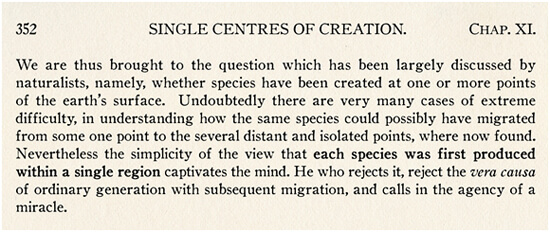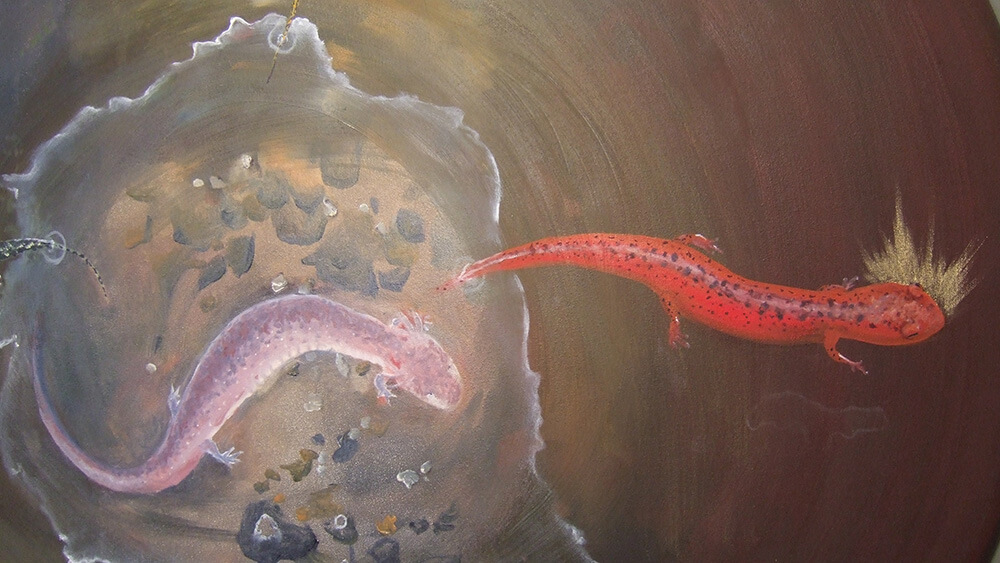Overview
Nancy Lowe approaches the idea of "single centers of creation" through salamander diversity in the Southern Appalachian mountains.
Essay
| Detail from Nancy Lowe, Source, Species Icons exhibit, Schatten Gallery, Emory University, Atlanta, Georgia, 2009. |
Introduction
In this sampling from ORIGIN, a collaborative exhibition celebrating the 150th anniversary of On the Origin of Species and the 200th anniversary of Charles Darwin's birth, artist Nancy Lowe approaches the idea of "single centers of creation" through the example of salamander diversity in the Southern Appalachian mountains.
Excerpt from Charles Darwin's On the Origin of Species, 1859:
 |
Artist's Statement
It has been thought that, because of the tremendous diversity of lungless salamanders (Plethodontids) in the Southern Appalachians and because of the age of this mountain range, these salamanders may have originated in our veritable backyard. Recent phylogenetic research has called into question this biogeographical idea; perhaps it is not as simple and straightforward as we thought. Species originate from one place, they disperse, migrate, branch into new species, some die off . . . but then climates change, continents shift, and some groups re-evolve ancient characters, or several distantly related groups evolve similar traits (called convergent evolution), confusing the evolutionary biologists who are trying to sleuth these mysteries. We only have a few twigs from which to guess at the shape of the whole tree.
Nevertheless, I find this idea of salamander origins in the Appalachians a powerful metaphor for origins of life. There are points of origin. Each branching on the tree is a point of origin and the beginning of a new line in the story. If we could trace all our origins all the way back, we would find that we salamanders, we hominids, we birds, we slime molds and mosses all came from one place—out of the water and out of the earth. The habitat of most salamanders is the moist earth, the kind of dark place that is recycled from death, yet lush with life. For me an image that bores into the center of the earth, to our origins, is equally sacred as one that opens up into heaven. Thus I have strived to honor this origin story with an earthy mandala.
Species of Plethodontid Salamanders of the Southern Appalachians
| Latin Name | Common Name |
| Desmognathus ochrophaeus | Allegheny Mountain Dusky Salamander |
| Desmognathus monticola monticola | Appalachian Seal Salamander |
| Plethodon chlorobryonis | Atlantic Coastal Slimy Salamander |
| Gyrinophilus gulolineatus | Berry Cave Salamander |
| Gyrinophilus palleucus necturoides | Big Mouth Cave Salamander |
| Desmognathus welteri | Black Mountain Salamander |
| Desmognathus quadramaculatus | Black-bellied Salamander |
| Pseudotriton ruber schencki | Black-chinned Red Salamander |
| Desmognathus orestes | Blue Ridge Dusky Salamander |
| Pseudotriton ruber nitidus | Blue Ridge Red Salamander |
| Gyrinophilus porphyriticus danielsi* | Blue Ridge Spring Salamander |
| Eurycea wilderae* | Blue Ridge Two-lined Salamander |
| Eurycea cf. quadridigitata* | "Carolina Dwarf Sal." |
| Desmognathus carolinensis | Carolina Mountain Dusky Salamander |
| Gyrinophilus porphyriticus dunni* | Carolina Spring Salamander |
| Eurycea lucifuga | Cave Salamander |
| Plethodon chattahoochee | Chattahoochee Slimy Salamander |
| Plethodon longicrus* | Crevice Salamander [SC] |
| Plethodon kentucki | Cumberland Plateau Salamander |
| Eurycea quadridigitata* | Dwarf Salamander [SC] |
| Pseudotriton montanus montanus | Eastern Mud Salamander |
| Plethodon cinereus | Eastern Red-backed Salamander |
| Hemidactylium scutatum | Four-toed Salamander [SC] |
| Aneides aeneus | Green Salamander [E] |
| Desmognathus imitator | Imitator Salamander |
| Plethodon jordani | Jordan's Salamander |
| Eurycea junaluska | Junaluska Salamander [T] |
| Gyrinophilus porphyriticus duryi | Kentucky Spring Salamander |
| Eurycea l. longicauda | Long-tailed Salamander [SC] |
| Stereochilus marginatus | Many-lined Salamander |
| Pseudotriton montanus diastictus | Midland Mud Salamander |
| Plethodon mississippi | Mississippi Slimy Salamander |
| Pseudotriton montanus | Mud Salamander |
| Desmognathus fuscus* | Northern Dusky Salamander |
| Pseudotriton ruber ruber | Northern Red Salamander |
| Plethodon glutinosus | Northern Slimy Salamander |
| Gyrinophilus porphyriticus porphyriticus | Northern Spring Salamander |
| Plethodon dorsalis | Northern Zigzag Salamander |
| Desmognathus ocoee | Ocoee Salamander |
| Gyrinophilus palleucus palleucus | Pale Salamander |
| Desmognathus wrighti | Pigmy Salamander |
| Pseudotriton ruber* | Red Salamander |
| Plethodon jordani | Red-cheeked Salamander |
| Plethodon shermani | Red-legged Salamander |
| Eurycea | "Sandhills Eurycea" |
| Desmognathus santeetlah | Santeetlah Dusky Salamander |
| Desmognathus monticola | Seal Salamander |
| Desmognathus aeneus | Seepage Salamander |
| Desmognathus marmoratus | Shovel-nosed Salamander |
| Plethodon teyahalee | Southern Appalachian Salamander |
| Desmognathus auriculatus* | Southern Dusky Salamander |
| Plethodon metcalfi | Southern Gray-cheeked Salamander |
| Plethodon richmondi | Southern Ravine Salamander |
| Pseudotriton ruber vioscai | Southern Red Salamander |
| Plethodon serratus | Southern Red-backed Salamander |
| Eurycea cirrigera* | Southern Two-lined Salamander |
| Plethodon ventralis (formerly dorsalis) | Southern Zigzag Salamander[SC] |
| Plethodon welleri ventromaculatus | Spotbelly Salamander [SC] |
| Desmognathus conanti | Spotted Dusky Salamander |
| Gyrinophilus porphyriticus | Spring Salamander |
| Plethodon aureolus | Tellico Salamander |
| Gyrinophilus palleucus | Tennessee Cave Salamander |
| Eurycea guttolineata | Three-lined Salamander |
| Plethodon wehrlei | Wehrle's Salamander [T] |
| Plethodon welleri | Weller's Salamander [SC] |
| Plethodon cylindraceus | White-spotted Slimy Salamander |
| Plethodon yonahlossee* | Yonahlossee Salamander |
| Plethodontidae: Lungless Salamanders, Tree of Life web project. | |
This essay is adapted from Nancy Lowe's exhibit Species Icons, Schatten Gallery, Emory University, 2009. 
About the Author
Nancy Lowe is a naturalist artist and scientific illustrator based in Atlanta, Georgia. She received her Bachelor of Fine Arts from the School of Art Institute of Chicago in 1986 and a post baccalaureate honors in biology from Georgia State University between 1992 and 1994. Currently she teaches nature journaling and scientific artistry at schools, universities, and museum workshops throughout Georgia.
Recommended Resources
Links
Discover Life
http://www.discoverlife.org/
Proceedings of the Appalachian Salamanders Workshop, May 30-31, 2008. Conservation and Research Center, Smithsonian's National Zoological Park, Front Royal, Virginia.
http://nationalzoo.si.edu/SCBI/SpeciesSurvival/AmphibianConservation/AppalachianSalamanderReport.pdf
Salamanders of Alabama
http://www.alabamaherps.com/salamanders.htm
Salamanders of Kentucky
http://fw.ky.gov/Wildlife/Pages/Amphibians.aspx
Salamanders of North Carolina
http://www.bio.davidson.edu/projects/herpcons/herps_of_NC/salamanders/salamanders.html
Salamanders of South Carolina and Georgia
http://www.uga.edu/srelherp/salamanders/index.htm
Salamanders of Tennessee
http://www.state.tn.us/twra/tamp/salamanders.htm
Salamanders of Virginia
http://www.virginiaherpetologicalsociety.com/amphibians/salamanders/salamanders_of_virginia.htm
Salamanders of West Virginia
http://www.marshall.edu/herp/Salamanders.htm
Welsh, Hartwell H., Jr. and Sam A. Droege, "A case for using plethodontid salamanders for monitoring biodiversity and ecosystem integrity of North American forests," Conservation Biology 2001: 15(3):558-569.
Wilson, E.O. The Diversity of Life. Cambridge, Massachusetts: Harvard University Press, 1992.



